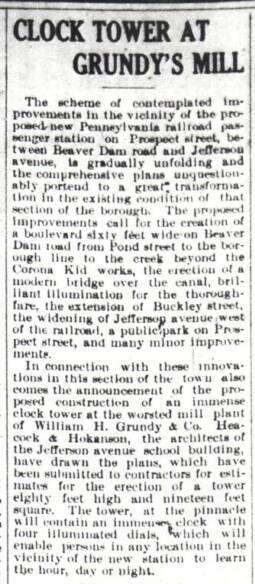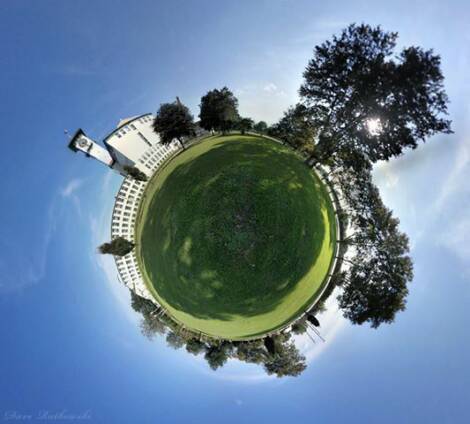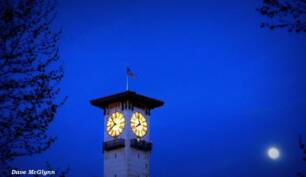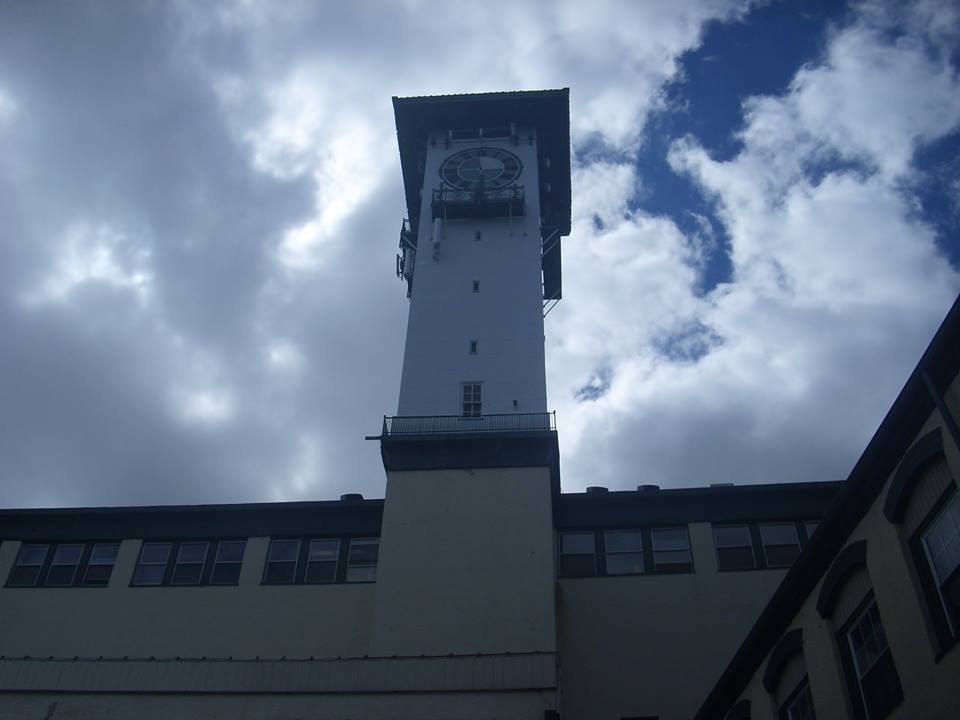A Sentry for Over a Century
by Cate Murway
Tick…tick…tick…Standing the test of time.
In 1910, work was begun on the latest concrete and steel construction skyline feature addition, unique for its time and still unduplicated, to the mill of William Hulme Grundy & Company. Today these mill buildings are significant as visual landmarks and, along with its most distinctive feature, the signature iconic Grundy Commons clock tower, as reminders of the industrial apex and the resurgence of manufacturing activity and the continuation of local employment.
No more "SECOND" guessing....
“The tower, at the pinnacle will contain an immense clock with four illuminated dials, which will enable persons in any location in the vicinity of the new station to learn the hour, day or night” was announced in the Gazette Observer in December 1910.
The immense 168 feet [51 m] tall clock tower, monumental in scale, with four 14-feet diameter clocks was commissioned by U.S. Senator Joseph R. Grundy and manufactured by the Seth Thomas Company, one of the most prolific and longest established clock makers in the United States. They had an impeccable reputation for designing and producing masterfully crafted renowned tower clocks including the massive timepiece at Grand Central Station in New York.
The Bristol clock tower once regulated the workers’ lives and their pocket watches.
There was no excuse for not knowing the time to report to work, or for the tardy youngsters, to be back at home or at school, with the Grundy Clock Tower looming overhead above Canal Street.
Ronald Wilson Reagan [1911-2004] was only six months old when the four-sided clock was put into operation in August 1911. A brass plate on the mechanism clearly marks the date. An electromagnet regulates the pendulum and a fist-sized electric motor keeps the clock monitoring time. When it was first constructed, the clock was wound up by hand, setting in motion the enormous pendulum propelled by a 700-pound weight. The tower is 14-feet square and there are four observation balconies.
Its estimated weight is over 112 tons. At night, when illuminated, the clock stands out distinctly from the evening sky, a symbol of historic Bristol on the Delaware, a beacon known all over Bucks County. The circular faces light up to display ornate wrought-iron clock hands and black Roman numerals.
The Grundy Brothers and Richard Campion had been manufacturing their wool tops and worsted yarn goods in Bristol instead of Philadelphia since September 1876 in The Grundy Mills Complex built by William H. Grundy and the Bristol Improvement Company, designed by architects, Joseph Linden Heacock and Oscar M. Hokanson.
The buildings, ranging in height from one to seven stories, operated as one unit for the milling, storage, and power and were constructed over a 55 year period. An early extension to the buildings began in November 1880. While other businesses faltered during the Depression years, over 850 workers were employed in the plant in the 20’s, making it the largest employer in Bucks County. It operated as a worsted mill until 1946. Its importance in Bristol was radical: the Grundy Mills employed approximately 30 percent of the town's industrial work force.
In 1827, a major event occurred in Bristol's economic development and transportation when ground was broken for the Delaware Division of the Pennsylvania Canal. Boatmen who earned their living by hauling cargo on their barges knew when they saw the clock at the Grundy Mills that they were almost at the end of their journey down the canal between Easton and Bristol.
This year's theme of Historic Bristol Day on October 19, 2013, sponsored by the Bristol Cultural & Historical Foundation, is the importance and history of the Delaware Canal to the town of Bristol.
So much of the Grundy Commons structure exudes Senator Joseph Ridgway Grundy’s tradition. Owner, Frederic H. Baumgarten feels a “privilege and responsibility to maintain” the historically retained complex, preserving the history and preparing for the needs of today. “We may use our past as the beacon to follow in navigating into our future.”
The Grundy Commons is an extraordinary and diverse environment of businesses with a renewed luster of flavor and character and will be sporting a new coat of crisp white paint on the clock tower that will gleam once more.
The complex mirrors the past but windows are always on the future and the clock is more than just a timepiece, so this is a restoration of pride for this visual symbol of home. The impressive 12- acre Grundy Commons complex, a most distinctive architectural landmark, was added to the National Register of Historic Places in 1986.
Industrial leadership, historic preservation with retention of history and authenticity, civic pride and revitalization surges through the Borough and Fred Baumgarten’s expansive Grundy Commons is primed and ready to provide additional new sources of office, warehouse and distribution space. He is always preserving the past and fortifying the future and Fred has benevolently offered to be the host location for the 2013 Third Annual Bristol Fall Classic on Saturday, November 23, 2013.
It’s about time….so, clock watchers unite
while the Grundy Commons timepiece is redressed for success.
Recommend a "Spotlight". E-mail vjmrun@yahoo.com


picture- Dave Rutkowski



picture- Dave Rutkowski
picture- Antonio Harvey

picture- Zappone Photography

picture- Antonio Harvey
